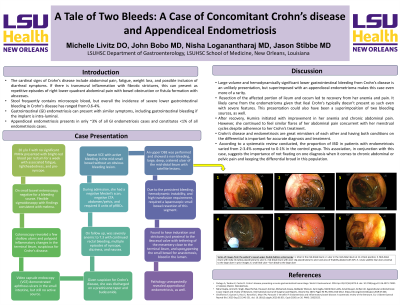Monday Poster Session
Category: IBD
P2693 - A Tale of Two Bleeds: A Case of Concomitant Crohn’s Disease and Appendiceal Endometriosis
Monday, October 28, 2024
10:30 AM - 4:00 PM ET
Location: Exhibit Hall E

Has Audio

Michelle Livitz, DO
Louisiana State University Health
New Orleans, LA
Presenting Author(s)
Michelle Livitz, DO1, John F. G.. Bobo, MD2, Nisha Loganantharaj, MD2, Jason Stibbe, MD3
1Louisiana State University Health, New Orleans, LA; 2LSU, New Orleans, LA; 3LSU Health New Orleans School of Medicine, New Orleans, LA
Introduction: The cardinal signs of Crohn’s disease include abdominal pain, fatigue, weight loss, and diarrheal symptoms. Stool can frequently contain microscopic blood, but the incidence of severe lower gastrointestinal bleeding in Crohn’s disease has ranged from 0.6-4%. GI endometriosis can present with similar symptoms, including GI bleeding if the implant is intraluminal. Appendiceal endometriosis presents in only ~3% of all GI endometriosis cases and constitutes < 1% of all endometriosis cases.
Case Description/Methods: 20 y/o F with no significant PMHx presented with bright-red blood per rectum, fatigue, and pre-syncope for one week. Initial evaluation included a negative upper DBE, a flexible sigmoidoscopy with melena, and colonoscopy with shallow ulcers and polypoid inflammation in the terminal ileum suspicious for Crohn’s disease. No active source of bleeding was found leading to a VCE with aphthous ulcers noted in the small intestine. She was discharged on a steroid taper and budesonide due to concern for Crohn's. On follow-up, she was symptomatic from severe anemia requiring hospital admission for transfusion. A negative Meckel’s scan and CTA abdomen/pelvis prompted a repeat VCE, revealing active bleeding in the mid-small bowel without an obvious lesion. An upper DBE followed, demonstrating a deep, distal ileal ulcer with satellite lesions. Due to persistent bleeding and hemodynamic instability, she underwent a laparoscopic partial bowel resection. Induration and strictures were found by the ileocecal valve with intraluminal blood, and pathology identified active enteritis, transmural inflammation, and non-caseating granulomas consistent with Crohn’s. Unexpectedly, an appendiceal endometriosis was also identified. She was started on Humira with improvement in her anemia and pain with intermittent flares during her menstrual cycles.
Discussion: Hemodynamically significant bleeding from Crohn’s disease is uncommon, but superimposed with an appendiceal endometrioma makes this case even more of a rarity. It is unclear if the etiology of the patient's bleeding was due to the active Crohn’s, the endometrioma, or a combination. According to a systematic review conducted, the proportion of IBD in patients with endometriosis varied from 2-3.4% compared to 0-1% in the control group. This association suggests the importance of not fixating on one diagnosis when it comes to chronic abdominal or pelvic pain and keeping the differential broad since IBD and endometriosis are great mimickers of each other.

Disclosures:
Michelle Livitz, DO1, John F. G.. Bobo, MD2, Nisha Loganantharaj, MD2, Jason Stibbe, MD3. P2693 - A Tale of Two Bleeds: A Case of Concomitant Crohn’s Disease and Appendiceal Endometriosis, ACG 2024 Annual Scientific Meeting Abstracts. Philadelphia, PA: American College of Gastroenterology.
1Louisiana State University Health, New Orleans, LA; 2LSU, New Orleans, LA; 3LSU Health New Orleans School of Medicine, New Orleans, LA
Introduction: The cardinal signs of Crohn’s disease include abdominal pain, fatigue, weight loss, and diarrheal symptoms. Stool can frequently contain microscopic blood, but the incidence of severe lower gastrointestinal bleeding in Crohn’s disease has ranged from 0.6-4%. GI endometriosis can present with similar symptoms, including GI bleeding if the implant is intraluminal. Appendiceal endometriosis presents in only ~3% of all GI endometriosis cases and constitutes < 1% of all endometriosis cases.
Case Description/Methods: 20 y/o F with no significant PMHx presented with bright-red blood per rectum, fatigue, and pre-syncope for one week. Initial evaluation included a negative upper DBE, a flexible sigmoidoscopy with melena, and colonoscopy with shallow ulcers and polypoid inflammation in the terminal ileum suspicious for Crohn’s disease. No active source of bleeding was found leading to a VCE with aphthous ulcers noted in the small intestine. She was discharged on a steroid taper and budesonide due to concern for Crohn's. On follow-up, she was symptomatic from severe anemia requiring hospital admission for transfusion. A negative Meckel’s scan and CTA abdomen/pelvis prompted a repeat VCE, revealing active bleeding in the mid-small bowel without an obvious lesion. An upper DBE followed, demonstrating a deep, distal ileal ulcer with satellite lesions. Due to persistent bleeding and hemodynamic instability, she underwent a laparoscopic partial bowel resection. Induration and strictures were found by the ileocecal valve with intraluminal blood, and pathology identified active enteritis, transmural inflammation, and non-caseating granulomas consistent with Crohn’s. Unexpectedly, an appendiceal endometriosis was also identified. She was started on Humira with improvement in her anemia and pain with intermittent flares during her menstrual cycles.
Discussion: Hemodynamically significant bleeding from Crohn’s disease is uncommon, but superimposed with an appendiceal endometrioma makes this case even more of a rarity. It is unclear if the etiology of the patient's bleeding was due to the active Crohn’s, the endometrioma, or a combination. According to a systematic review conducted, the proportion of IBD in patients with endometriosis varied from 2-3.4% compared to 0-1% in the control group. This association suggests the importance of not fixating on one diagnosis when it comes to chronic abdominal or pelvic pain and keeping the differential broad since IBD and endometriosis are great mimickers of each other.

Figure: Series of images from the patient’s repeat upper double balloon enteroscopy: 1. Ulcer in the mid-distal ileum; 2. ulcer in the mid-distal ileum at 11 o’clock position; 3. Mid-distal ileum with india ink tattoo placed lateral to ulcer 4. mid-distal ileum with ulcer clip placed lateral to ulcer and area of friability ablated with APC; 5. small, satellite ileal ulcer proximal to the large ulcer in prior images; 6. small ileal ulcer ~5cm distal to the large ulcer
Disclosures:
Michelle Livitz indicated no relevant financial relationships.
John Bobo indicated no relevant financial relationships.
Nisha Loganantharaj: Abbvie – Speakers Bureau. Bristol Myers Squibb – Speakers Bureau. Eli Lilly – Advisory Committee/Board Member, Speakers Bureau. Takeda – Speakers Bureau.
Jason Stibbe indicated no relevant financial relationships.
Michelle Livitz, DO1, John F. G.. Bobo, MD2, Nisha Loganantharaj, MD2, Jason Stibbe, MD3. P2693 - A Tale of Two Bleeds: A Case of Concomitant Crohn’s Disease and Appendiceal Endometriosis, ACG 2024 Annual Scientific Meeting Abstracts. Philadelphia, PA: American College of Gastroenterology.
